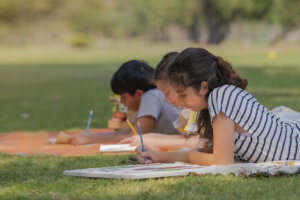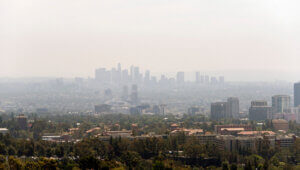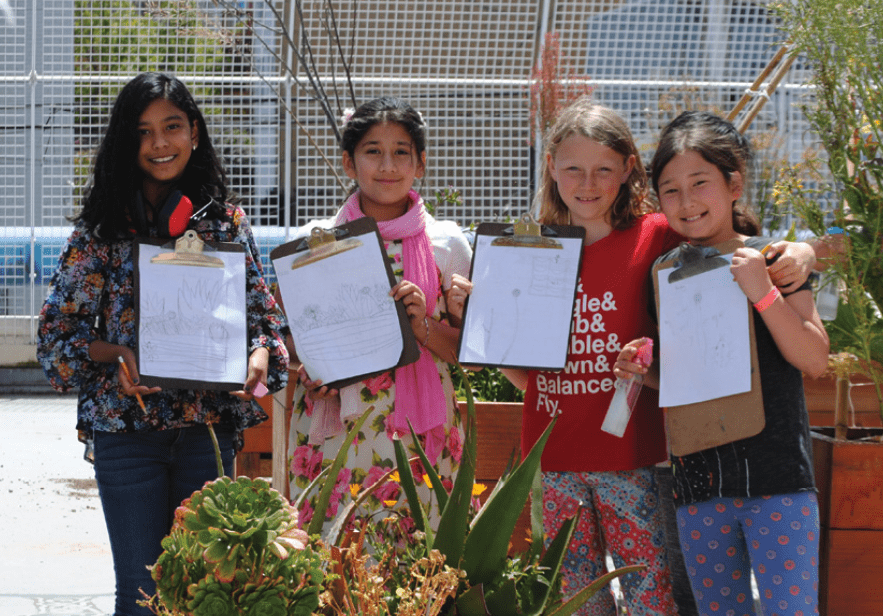“Look, there’s water in my bag! Why does my bag have more water than yours? What happened to the leaves?”
These were my student’s observations as he took off the rubber band that was wrapped around a clear Ziploc bag covering a small batch of leaves on a tree. This was a result of an outdoor activity in which my students wrapped a clear Ziploc bag around a few leaves on a tree, then left it overnight to see the process of transpiration. Students were amazed at the amount of water loss in a 24-hour period. They were able to compare the amount of water loss and conclude that it was a result of the increase in heat because some Ziploc bags were under the shade, while others were not; they were able to see the effects of water that had escaped through the stomata of the leaves and how condensation followed evaporation. But most importantly, I could see their excitement as they ran from tree to tree sharing and comparing their results with one another.
That level of student engagement was very different than when we read about transpiration in the classroom and analyzed the diagram in their textbooks about plants needing to release oxygen back into the atmosphere. I knew that this way of learning was more meaningful to them because they were able to experience it instead of reading about it and looking at a diagram. This outdoor activity had a much greater impact on my students because it provided them with a direct interaction—what I like to call a “transaction with nature”—between humans and the natural world. Even though this outdoor activity involved only a Ziploc bag and a rubber band, it provided my students with an engaging and enjoyable learning experience that led them to make inquiries and comparisons, find patterns, and establish a sense of connection with our natural world. I believe the main component in this activity wasn’t the simple items, instead it was that the outdoors provided students with a meaningful and engaging context to learn science.
Not only do outdoor learning experiences engage students, they also provide opportunities for students who typically struggle in the classroom. For example, I observed students who are normally challenged by content taking charge of their learning by asking questions and offering solutions to problems. Students displayed a higher level of inquiry that reflected a more in-depth understanding of the topic as evidenced by their level of questioning. Most students expressed their enjoyment and exhilaration at being able to go outside and engage in hands-on activities. Additionally, I’ve noticed an increased level of engagement in content learning when students return to the classroom and are tasked with related assignments. Moreover, struggling students built their self-esteem by collaborating with peers and being part of an investigative team.
As an educator and participant of Montebello Unified School District’s environmental science literacy committee, I’ve come to understand that educators are an essential component in moving beyond intellectual transactions in classrooms to outdoor learning transactions with nature. Collaborating with my middle school colleagues while attending the professional development trainings, we have been able to understand the importance of going beyond the three dimensions (disciplinary core ideas, cross-cutting concepts, and science and engineering practices) of the Next Generation Science Standards (NGSS) and making outdoor learning experiences relevant to student interest. I believe that working collaboratively we can harness students’ passion for science and use it to increase environmental literacy, while providing opportunities for our students to engage in multiple transactions with nature that emphasize the interconnectedness between humans and the natural world. Teaching science outdoors provides powerful learning experiences for all students regardless of their abilities. When instruction is taken outdoors with specific learning outcomes, I’ve observed a higher level of student engagement and effectiveness in teaching content.
Throughout a series of professional development trainings, we discussed the benefits of having students learn science through investigations that focus on topics of interest and relevance to their communities. We engaged in rich conversations about how students gain a feeling of agency and connectedness to their learning. We worked collaboratively by grade level to write lessons that encompass outdoor learning experiences, and are connected to learning outcomes and expectations relevant to targeted science standards. We learned to bring the disciplinary core ideas, cross-cutting concepts, and science and engineering practices of the NGSS to life in ways that were engaging and achievable in addition to learning about environmental anchoring and investigative phenomena through the lens of NGSS. This level of collaboration and commitment from all participants inspires me to continue my mission of empowering my students to become agents of change by increasing environmental literacy and instilling a passion for protecting our land.
I am grateful to the Montebello Unified School District, working in partnership with the State Environmental Education Roundtable, and am extremely excited to be part of this elite group of educators embarking on this journey of collaboration, coordination, and commitment in planning a roadmap for science and environmental literacy for our district. As we continue on this journey, I am certain that we are creating a pathway for our students to become stewards of our land by continually providing them with many opportunities to have transactions with nature as we take science instruction outdoors beyond the classroom. In the future, I am confident that students will have a greater understanding of and appreciation for our interconnectedness with nature as they tackle environmental challenges. This understanding was exemplified by a statement made by my student as we walked through our school campus to observe natural and human systems:
“It’s not about man versus nature, it’s about man bonding with nature.”










